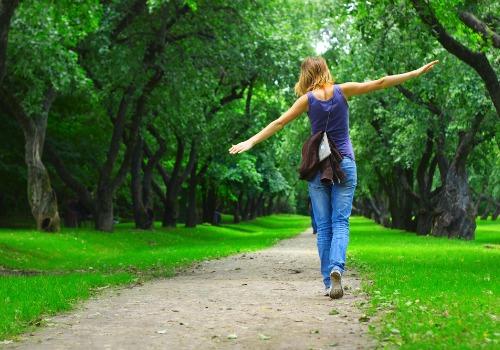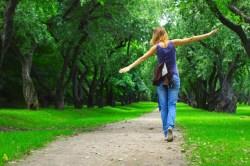This past month, I’ve discovered a groundbreaking method for turning ordinary foodstuffs into fuel. The potential is boundless, as practically any food item will do — pumpkin seeds, cereal, and salmon fillets can all transform into the energy required to get you almost anywhere you need to go, while emitting almost no extra greenhouse gases.
Here’s how it works: Eat food. Allow your digestive system convert it into glycogen, which provides energy to your muscles that can be used to power physical motion. Then walk.
True, this method is not exactly swift if your destination is, say, Anchorage.* Within two miles, though? Food-fueled transportation — a.k.a. walking, biking, hopscotching, what have you — can be just as efficient (and when parking is involved, often faster) as hopping in the car. And when you consider that 40 percent of all automobile trips occur within a two-mile radius of wherever we are, the so-called Two-Mile Challenge becomes a truly viable option for putting a cork in the carbon emissions spewing from the typical American lifestyle.
Traditionally, the challenge calls for using anything but the car for local trips, so public transportation is totally legit (and rightly so). I happen to live in a bus-happy Seattle neighborhood, but when I embarked on the Two-Mile Challenge for the month of October, I decided to up the ante and challenge myself to travel via human-powered locomotion as much as possible for my 31 days. I wanted to see how well this endeavor might work for folks living in less connected locales. Besides, haven’t you heard? Sitting – on a bus or otherwise — will kill you.
I generally walk a lot anyway, but who among us is completely immune to exhaustion, or just plain laziness? So last month, I got to test myself right away when The Moth, a supercool story performance event, came to my neighborhood in early October. My distance from the venue: 1.3 miles, according to Google Maps (an absolutely essential tool for prospective Two-Milers). Yes! A chance to walk the walk.
“We need to walk up to the Fremont Abbey for the show tonight,” I informed my boyfriend, Ted, that morning. “But it’s all uphill!” he said. “And I don’t want to be late.” He’d just identified two of the Big Three stumbling blocks that plague Two-Milers everywhere: physical effort and time. (The third one we’ll call comfort, but more on that in a minute.) But we would overcome. “It’ll be fine if we leave right after work,” I told him. “And stop whining.”
Turned out that, having four healthy legs between us, strolling 1.3 miles was no biggie — even at a 20-percent grade. And on such a lovely fall evening, the walk gave us a chance to unwind after a long day and deep-six the frantic urban ritual of parking-space hunting.
Then, after the show, our friends offered us a ride home. Ted and I looked at each other, then shook our heads. “We’re trying to walk everywhere within two miles,” I explained. They raised an eyebrow to that, but still we strode off. We live on their way home, so we hadn’t actually prevented any carbon from burning, I reflected as we went. But surely our shining example would inspire them the next time they headed out.
Other occasions were tougher. Our favorite grocery store is 1.4 miles away, but up a much bigger hill than the last one. Biking up that thing was out of the question, per the laws of physics — and unless we wanted to make the trip every day, Two-Miling it there would require hauling loads of groceries, Sherpa-style.
Still, energized by my goal, I figured out a workaround. Shopping trips, meet intentional workouts: I’d lace up my athletic shoes and run up the hill and around the neighborhood. Then I’d hit the store, load up a backpack or a couple of bags with food, and walk back home. Since I would’ve worked out anyway, the shopping trip didn’t take much extra time — and never have my quads benefited so much from running out of milk.
But lest you think I am some kind of Two-Mile angel, we hit our share of jams this month, too — all courtesy of the Big Three challenges of time, physical effort, and comfort. Like the time our friends called to invite us on a last-minute weekend trip, and could we please pick up dinner ingredients? The scene: Friday night, getting ready to leave early Saturday morning. Walking to and from the grocery store would take more than an hour, and we still needed to pack. No bus line runs directly up there, either.
We thought about walking, we really did. Then we thought about making an end-run around the rules by driving to a store that lies outside my Google-Mapped, two-mile perimeter. Then we decided that burning more gas chasing a technical victory was not quite in keeping the original spirit of the challenge, said, “Oh, screw it,” and drove. Thirty minutes later, we were home with supplies. Running errands under human power is easily managed with a little planning, and maybe some sweet bike panniers, but you can’t plan for everything.
Then there are the times comfort comes into play, like when we ordered a pizza from our favorite local joint, 1.8 miles away and a pleasant stroll when it’s not raining bathtubs — which it proceeded to do 20 minutes before our scheduled pickup time. I considered our options: Bike there, and fold the pizza to fit into a backpack? Walk, and bring the pizza its own raincoat? (What’s that — an umbrella for the pizza? Don’t be ridiculous.) When it came down to it, we just didn’t feel like struggling through the cold downpour for 40 minutes, desperately trying to protect the cheesy goodness from going soggy. So we drove.
Here’s the deal with challenges like this one: If you really want to succeed, you’ve got to stop thinking “challenge” and start thinking “opportunity.”
It’s not about subtracting driving; it’s about adding walking. Instead of, “You must walk everywhere within two miles without exception or face crippling guilt and the judgment of your community,” tell yourself, “Let’s take every opportunity to walk/bike/hopscotch more — as much more as we can!” That way, you will drive less and convert PBJ into fuel more while actually enjoying the process – and you’ll do it more and more often, and for farther and farther distances, as you get in the habit of it.
And you know what? That’s exactly what I did. With the Two-Mile Opportunity on my mind, I definitely walked and biked more where I used to default to gasoline-powered convenience. I got to stretch my legs more, and in a twofer bonus, I often dragged my boyfriend along with me. And the best part? The Two-Mile Challenge ended on October 31, but baby, the Two-Mile Opportunity doesn’t have an expiration date.
*Does not apply if you live in Anchorage.




